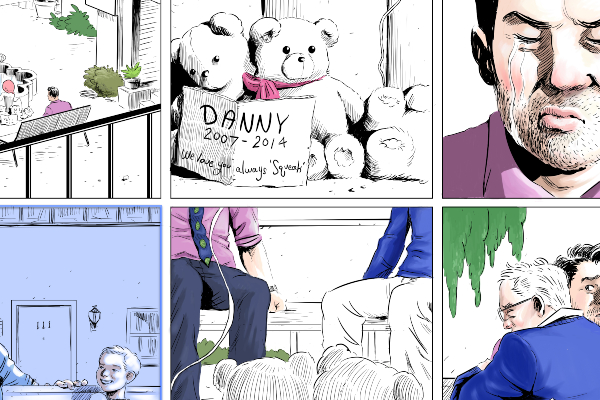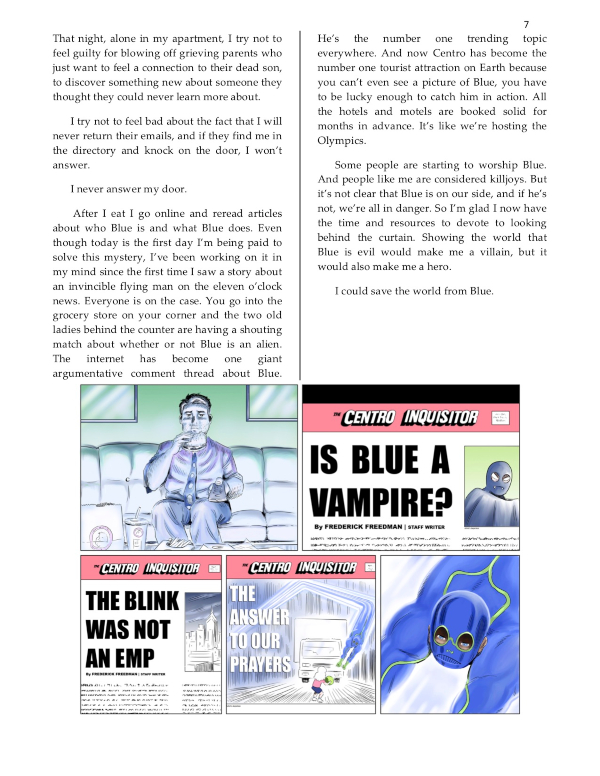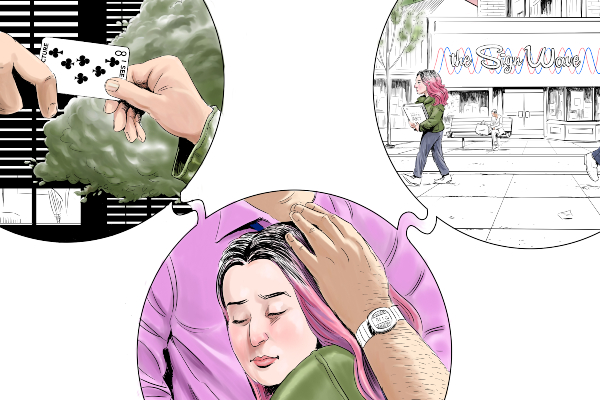Author Dave Terruso is bringing a new kind of superhero tale to IndieGoGo in September. Blending an intriguing premise with an inventive format, Alter Ego is a half comic/half novel series that tells the story of the villainous Erika Foster hiring a detective to uncover the identity of Blue, the world’s first and only superhero.
We caught up with Dave to discover more about his decision to make Alter Ego a mixture of literary and sequential story-telling!
A Place To Hang Your Cape: Why did you want to make Alter Ego a fusion of a graphic novel and a literary novel?
Dave Terruso: Short answer: It was an organic decision born out of what I wanted as a reader.
Long answer: I’ve been a traditional novelist since I started writing at age 11. I loved superhero movies but I had no real exposure to the comics. As I matured as a novelist, I decided to focus on mystery stories because I loved writing them the most. My two published novels are murder mysteries.
And one day I had this idea about doing a mystery novel where the mystery was “What is the secret identity of some superhero?” And I got obsessed with it. I knew I wanted to do a combination of the kind of comedic neo-noir mysteries I did in my first two novels and a traditional superhero story. So I spent a year consuming classic graphic novels (Watchmen, The Dark Knight Returns, Arkham Asylum, The Killing Joke, etc.) and comics to give myself a strong foundation in the genre. I also watched a lot of cartoons, the old Max Fleischer Superman cartoons, Batman: The Brave and the Bold – which was particularly helpful because most episodes contained the origin of lesser-known heroes like Plastic Man and Booster Gold.
I had a hard time adjusting to comic book reading after 30+ years of only reading text. I found that I would just read the speech and thought bubbles and barely even look at the images. I was skipping the best part, the part that makes a comic a comic. The artwork was beautiful, and the speech bubbles felt like an intrusion that sometimes overwhelmed the composition. Plus, I wanted more words to read. And one day the thought just popped into my mind, “What if I split the book in half, make the top half all text, and the bottom half all illustrations with no speech bubbles or text at all?”
I let that thought simmer a couple weeks while I was outlining and researching, and it stuck. I had no idea what I was doing, or how I would do it, I just knew I wanted to do it. I was too naïve to know what this would entail.
AP2HYC: What would you say the text sections of the comic accomplishes over the sequential sections, and vice-versa, in terms of telling the story?
Terruso: When I started writing Alter Ego, the idea was to have the images depict what the text described. “Read the text, watch the movie” was how I was describing it to people.
I write in strict first-person POV, present tense, always. My work is intensely personal, and I want you to live in my main character’s skin for the entirety of the story, and experience what they do in real time. That style lends itself well to mystery writing, where surprises and twists are the bread and butter. But it limits how much suspense you can build because you can’t show anything being set in motion behind the narrator’s back.
I would write a chapter of Alter Ego and then stop and write the panel descriptions for each page in that chapter. Halfway through the end of the first issue, there was an image that the narrator couldn’t possibly see that I really wanted the reader to see. Blue, my superhero, is distraught after a rescue isn’t entirely successful, and he flies into a river and curls up in the fetal position on the riverbed crying, and all the fish form this semi-circular bubble around him as they watch him, almost like worshippers. It was this very weird, very clear image I had that I knew was important for the reader to see. And that was the first time I thought “Maybe sometimes the images show us things the narrator can’t see.”
Once I had that epiphany, the content in the panels transformed into information the reader didn’t have – behind the scenes, between the lines, happening elsewhere, flashbacks, etc. I decided that the text would stay in strict first person, and the images would be in omniscient POV. And then I went back and redid all the panel descriptions in the first two issues with that in mind – which took months.
That decision blew the world of this book open for me. I could world-build in the images in a way that really engages the reader instead of feeling like exposition. It led me down roads I never would’ve explored otherwise, and fleshed out the world for me in surprising ways.
Club, my main character, says this line about a criticism his mom made of him as a child. It’s one line in the book, but I knew it was the emotional wound that formed his character. And when I did the images for the page that contained that line, I ended up showing flashbacks of his relationship with his mother when he was a child, and that was how I discovered that Club’s mom was very mentally ill, something that hadn’t occurred to me before. It was why he was so scarred. I sensed it, but it was a door I hadn’t opened at the end of a long hallway I hadn’t bothered to walk down.
Writing the panel descriptions has forced me—and allowed me—to look at every nook and cranny of this universe, and it’s the most fun I’ve ever had exploring as a writer.
AP2HYC: What challenges does this mixture of styles present to you as the writer/creator?
Terruso: I am not a visual artist at all. I draw at a 2nd grade level. And I have no background in art or design. So I knew I’d have to find a great illustrator, and I found that in Nick DeStefano. My challenge was describing things to him in a way that would translate into a still image.
I do have some limited background in film-making, and I’m able to translate some of those principles—composition, light, shadows, angles, etc.—into my descriptions, but it took me a really long time to be sure I was describing a still image and not something that would take three or four panels to illustrate.
Once I tasked myself with making sure the panels didn’t just repeat what was in the text, there were times when trying to show the reader something not covered in the text seemed impossible, and I’d sit there for a day or two racking my brain, straining to come up with something to show them that they didn’t already know. I didn’t want any filler panels at all.
I’m also never sure that I’m not describing a drawing that will be impossible to pull off. Luckily Nick is incredibly versatile, and he rolls with whatever I put in front of him. I can’t think of a single instance where he’s said, “I just don’t know how to pull this off. Can we change it?”
AP2HYC: How will the story develop over its seven issues?
Terruso: I’ve written the first four issues, which were originally going to be the first two of three novels. Breaking the first two novels into 2 issues each came out of necessity when I realised I’d have to front the money for these myself. Luckily I had broken each of the first two books into two parts from the beginning, as another way of splitting everything in two. If each page was going to be half text and half comic book panels, why not have the first half of each book be a mystery and the second half of each book be the adventure that the solution to that mystery brought about? So that meant that splitting the books in half would still give the reader a satisfying resolution and an enticing cliffhanger at the end of each half.
The first four issues tell one long story. The first page of the 3rd issue is actually the last page of the 2nd issue (same text but new images), as that was where I had folded the two novels together.
In Issue 1, Club is hired by an arch-villain named Erika to find out Blue’s secret identity. He does that by the end of issue 1. In Issue 2, Club has to turn his back on Erika to protect Blue from her evil scheme. In Issue 3, Blue hires Club to uncover his origin, which he can’t remember. In Issue 4, the revelation of Blue’s origin puts Club and the people he loves in danger, and he has to do what he can to save them.
The third novel, which I realised needed be split into 3 issues, tells a new story about these characters that I can’t tell you anything about because it would spoil the many reveals of the first four issues. Just know that it’s a drastically different story, and it’s more of a horror story than a mystery.
(There is a horror element that runs through this narrative, that started with the idea that if a superman punched a human being, their head and limbs would fly off because it would be the same amount of force as being hit by a train.)
I’ve made a very rough outline of the final three issues but haven’t started writing them yet.
AP2HYC: What inspired you to create this story?
Terruso: I’m a mystery writer first and foremost. So it always starts with the solution to a mystery that I don’t think most people will guess.
I came up with a secret identity for a superhero that I didn’t think anyone would guess, and I typed it up in a Word doc and saved it in a folder called Story Ideas.
As I said before, my writing is incredibly personal. I need to express where I’m at in my life when I’m writing a book. So, when I’m ready to start a new book, I go through the Story Ideas folder and see if any of those concepts fits well with what’s happening to me. And Alter Ego fit perfectly. At its core, Alter Ego is about a lonely man, Club, who longs to have a family, and that really resonated with where I was and am in my own life: wanting to start a family.
Once I lock in on one idea, I spend a year gathering ideas, watching the movie of the story in my head over and over, discarding what doesn’t work and keeping what does. I write dozens of drafts in my mind before I start writing the first page. My first written draft is probably like most author’s 8th or 9th draft. I find it much easier to get rid of a bad idea when it’s just pictures in my head instead of 30 pages of writing I’ve let myself fall in love with.
AP2HYC: Why choose to fund the project through IndieGoGo?
Terruso: The crowdfunding decision was born out of necessity.
I had a literary agent. My first two books were published traditionally as e-books only through a now-defunct publisher. Before that, the second of those novels was shopped around to all the major publishers, and ¾ of them loved it; they basically said “we love this book, we love this author, but no one’s buying books about this topic, so we’ll pass, but we can’t wait to read his next book!” Which was both deflating and very encouraging. I had my foot in the door with several big-name publishers, and I set to writing Alter Ego thinking this was what would lead to my big break.
When I finished the book and sent it to my agent, she told me that she didn’t represent illustrated novels, and that none of the editors who loved my writing published illustrated novels.
So I had to try to find a new agent just for this book, and people didn’t understand the format. One agent’s rejection was along the lines of “This seems awesome, but I honestly don’t know how to pitch it to a publisher.” That was more deflating than encouraging.
After several rejections and a slew of no-responses, I started researching indie publishing and saw it as a great opportunity. Before a traditional publisher published my first book, I had self-published it and sold 700 copies, so I wasn’t new to the process.
The major hurdle was the cost of the illustrations. Each issue will cost me at least $15,000. So I looked into crowdfunding. I attended a crowdfunding seminar where the head of their comics division (who was also a former comics editor at DC) told me my book wouldn’t be a good fit for crowdfunding because it would be so many months after the campaign ended before people got the book.
I didn’t know what to do. Everywhere I looked, I saw a NO. And then one day I looked at my 401(k) and did the math and realised I could take a loan against it to get half the money for half of one book, and use my tax return and my day-job bonus and freelancing money to cover the rest. That’s how I decided to publish the book in issues instead of novels.
So that’s what I’ve done. I paid Nick out of my own pocket to do Issue 1. And now anyone who buys it through the IndieGoGo will have it in their hands within a month of when the campaign ends.
I picked IndieGoGo in general because it’s become a popular destination for indie comics lately, and because they offer a flexible goal where, if you don’t hit your goal, you still keep what you’ve made, which was important to me because I’m moving forward with this no matter what I make.
AP2HYC: What style does artist Nick DeStefano bring to the book?
Terruso: I can’t sing Nick’s praises enough. This is a very detailed story and I’m very precise in my descriptions. Nick has had to keep track of so much minutiae that I’m not sure how he hasn’t lost his mind. Not only does he keep track of it, but on a regular basis he adds details to the panels that improve them.
What drew me to him at first was the humanity in his drawing. He drew people who looked and felt real, who made facial expressions and posed in ways that real people do. My writing is very character-focused, so his style was the perfect complement to that. He draws evocatively, and that was essential. Some of the sadder things he’s drawn for Issue 1 have brought tears to my eyes.
We decided to heighten the focus on the characters by leaving most of the backgrounds of the images uncoloured. It draws your eye to the people and to certain details we want you to focus on.
The book also requires a lot of representational drawing, and Nick is superb at that. Too much of a stylised approach wouldn’t allow me to tell the story with the clarity I needed.
He regularly surprises me with his interpretations of my descriptions, and how he elevates them with strong choices. There’s an image early in the book where Blue is above a crowd, and I wrote “some of them are cheering, some are sneering.” When I got the artwork I started laughing because one guy right in the centre of the crowd was giving Blue the finger. That’s a small example, but he’s done it on a larger scale too. I’m all too happy to change the text to fit what he draws if I like it better than what I came up with.
He and I have been working on this together for five years now, and it’s been a really rewarding collaboration that I think has challenged and improved both of us.
AP2HYC: What’s been the process like of bringing Alter Ego to life?
Terruso: Incredibly gratifying.
I think most authors dream of seeing one of their books made into a movie someday. I certainly do. Seeing Nick’s finalised illustrations is like that for me. He’s taken the ideas I had in my mind and made them a reality. Every time I get an email from him with the next two pages of panels, I get so excited to see more of this imaginary world made flesh.
I’m very lucky to have found such a talented artist who cares about this world I made up almost as much as I do.
You can discover more about Alter Ego and stay up to date with news of its campaign via its website. Will you be backing the book? Let us know in the comments section below or send us a Tweet!








I was lucky enough to read an early version of Alter Ego and I am very excited to get my hands on a finished version! It’s fantastically fun!
I love this whole concept and can’t wait to read the book! Yes I’ll be backing it!